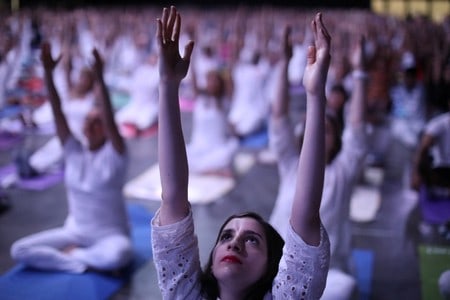By Lisa Rapaport
(Reuters Health) – Adults who practice yoga with breathing and relaxation exercises at least three times a week may have lower blood pressure than people who don’t, a research review suggests.
For the study, researchers analyzed data from 49 trials with a total of 3,517 participants who were typically middle-aged, overweight women and men who already had high blood pressure or were close to developing the condition. These smaller trials assessed blood pressure before and after participants were randomly assigned either to doing yoga or to a control group without exercise programs.
Overall, the people in the yoga groups experienced average reductions in systolic blood pressure of 5 mmHG (millimeters of mercury) more than those in the control groups, and diastolic blood pressure was reduced by 3.9 mmHG more with yoga.
When people with high blood pressure did yoga three times a week in sessions that also included breathing and relaxation exercises, they experienced average decreases of 11 mmHG more than control groups in systolic blood pressure and 6 mmHG more in diastolic blood pressure.
“Our results not only showed that yoga can be just as, or even more effective than aerobic exercise to reduce blood pressure; but also quantitatively showed the importance of emphasizing yoga breathing techniques and mental relaxation/meditation along with physical forms during practice,” said lead study author Yin Wu, a researcher in kinesiology at the University of Connecticut in Storrs.
“So, yoga, among other lifestyle interventions (such as diet and smoking cessation) should be adopted early on even when the blood pressure is still relatively low, and should be continued along with medication when blood pressure is relatively high,” Wu said by email.
Yoga appeared beneficial, but less so, when people practiced regularly but didn’t focus on breathing and relaxation or meditation. Under these circumstances, yoga was associated with average drops of 6 mmHG more in systolic blood pressure and 3 mmHG more in diastolic blood pressure compared to the groups doing no exercise.
In adults, a normal or healthy blood pressure reading is considered to be 120/80 mmHG or lower.
People in the study started out with average blood pressure readings of 129.3/80.7 mmHG. This suggests the reductions associated with yoga might be enough to return some people to the normal range.
The first number in the reading, known as systolic blood pressure, is the pressure blood exerts against artery walls when the heart beats. The second number, known as diastolic blood pressure, represents the pressure between beats when the heart is at rest.
One limitation of the study is that researchers lacked data on the intensity of yoga practices, including how long people held poses and how rapidly participants transitioned from one position to the next, the study authors note in Mayo Clinic Proceedings.
And while yoga with relaxation techniques appears to be beneficial, a separate study in the same journal offers a reminder of the potential risks for some in a review of records from 89 patients with injuries caused primarily by yoga.
The study looked at the types of injuries that occurred and found that 66 people had soft tissue injuries including pain from overuse, and six had discomfort or mobility limitations around a rotator cuff in the shoulder. In addition, 46 people experienced aggravation of pain from degenerative joint disease, while 13 had compression fractures.
These observations only included injured people, researchers note. The study wasn’t designed to determine whether or how yoga might directly cause injuries.
“In general, yoga improves balance, strength and flexibility, but trying to be extremely flexible with fragile joints can cause problems,” said senior study author Dr. Mehrsheed Sinaki, a rehabilitation specialist at the Mayo Clinic in Rochester, Minnesota.
“Also, if a person is 70 or 80 and does too many hip-opening movements or hyper extensions, they may develop hip pain,” Sinaki said by email.
While most people can practice yoga safely, older people with osteoporosis (thinning, brittle bones) should be careful, agreed Dr. Edward Laskowski, coauthor of an accompanying editorial and co-director of Mayo Clinic Sports Medicine.
“Rather than a one-size-fits-all approach, an individualized exercise prescription which takes into account a person’s unique medical history and personal goals should be considered,” Laskowski said by email.
SOURCE: https://bit.ly/2BUUSXO , https://bit.ly/2Ejzkof and https://bit.ly/2BYnRtJ Mayo Clinic Proceedings, online February 18, 2019.


